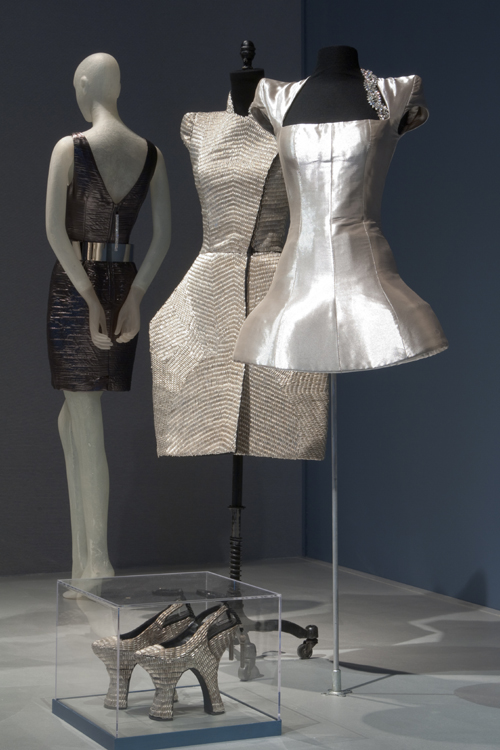Daphne Guinness Exhibition at The Museum at FIT
/by E.P.Cutler "Daphne Guinness in Water" Los Angeles, CA 2008. Photograph by David LaChapelle.
It is rumored that Bernard-Henri Lévy originally wooed Daphne Guinness with the line, “You are no longer a person; you are a concept,” an idea that her eponymous exhibition at The Museum at FIT further solidifies. The multi-media exhibition co-created by Valerie Steele and Guinness features over 100 garments and accessories, as well as a number of short films and a floating hologram of Guinness (à la Kate Moss for Alexander McQueen’s Fall 2006 collection.)
The show begins with a concise cabinet of curiosities featuring Guinness’ trademark sky-high shoes. The gravity-defying platforms by Olivier Theyskens for Nina Ricci are on display. (Gaga fans, Daphne wore them first.) Alexander McQueen’s take on the motorcycle boot complete with a one-and-a-half inch spike jutting out like a modern-day spur is available for viewing, as is one of his baroque botany creations with flowers for platforms and leaves for heels. The first garment on display is by McQueen as well: a custom-made meticulously bejeweled catsuit with flowing cape. The cape appears ethereal, as if the fabric was somehow made out of jellyfish. Even without Daphne in it, it seems to emanate an aura.
Fine mesh screens divide the main exhibition space into themed rooms: “dandyism, armor, chic, evening chic, exoticism, and sparkle.” (The screens, a brilliant curatorial choice, allow for the mannequins to be positioned in a plethora of ways, which avoids monotony and still allows for visibility. The back of the garment may face the viewer on one side, but the front is still visible through the screen on the other side.) The “Dandyism” room shows fiercely structure ensembles. Apparently, Guinness' balks at the renewed interest in la garçonne styles, perferring to embracing a chromophobic version of dandy masculinity. Ultimately, though, all of the outfits seem to be feminine versions of Karl Lagerfeld’s personal uniform. Not coincidentally, many of them are made by “the Kaiser” himself.
Dresses and shoes from the ARMOR. Photograph courtesy The Museum at FIT.
Another room, and perhaps the most interesting one, is “Armor.” Daphne Guinness is quoted saying, “I think it’s very beautiful to be able to cover yourself in metal. I love the color and the way it reflects. But it is also a protection.” I wish the exhibition completely revolved around Guinness’ use of fashion as a protective armor, a pervasive thread throughout the oeuvre of her wardrobe. Toward the end of the exhibition, mannequins don not only her clothing, but also wigs of iconic Daphne Guinness hair. The wigs, created by Isaac Davidson of Wigbar, are the best I’ve ever seen exhibited and create a haunting effect of an army of Daphne Guinnesses, which would perhaps be Guinness’ best bet at armor.
While the exhibition is a triumph and a must-see, it leaves one with more questions than answers. Daphne Guinness’ personal history and significance as a fashion figure is briefly alluded to but not delved into. It is taken for granted that the viewing demographic is already well versed in her noteriety. (Granted, those at the opening—including fashion’s biggest and brightest bold names: Valentino, Cecilia Dean, Oscar de la Renta, Calvin Klein, Derek Blasberg, and Stefano Tonchi—were quite familiar with it all.)
Hopefully, the forthcoming book will offer more insight into Guinness. However, I doubt it. Guinness has mastered the art of the British aristocrat, where seeing and revealing are entirely different things. A life of wealth and visibility has rendered Guinness the perfect postmodern icon, hyper aware that she has become a hyper-real version of herself. What a concept.
Red suede shoes by Nina Ricci. From the collection of Daphne Guinness, to be featured in the exhibition Daphne Guinness. Photograph courtesy The Museum at FIT
The show runs from now until January 7, 2012.
E.P.Cutler is currently a Master of Art Student of Fashion Studies at Parsons The New School for Design. She worked as an Archival Researcher on the film, Diana Vreeland: The Eye Has To Travel, which will be in theatres spring 2012. With a background in fashion journalism, she has written for New York Magazine, Marie Claire, and MYKROMAG.








